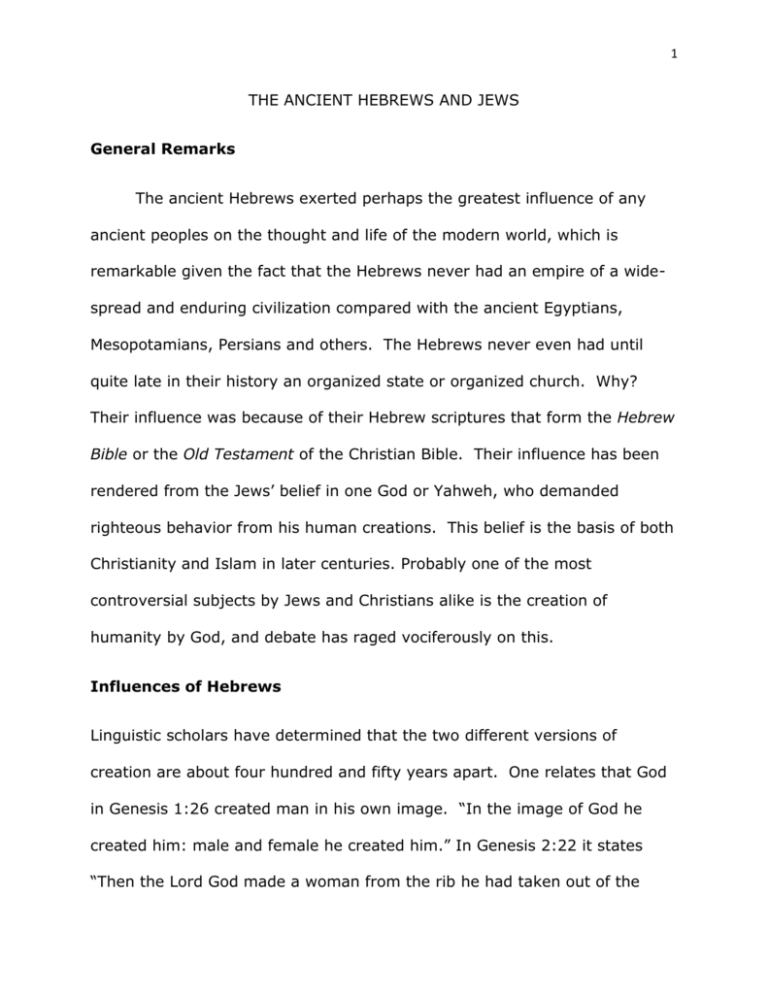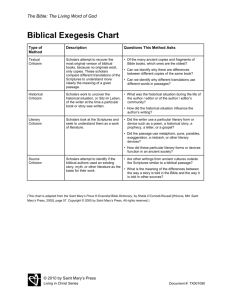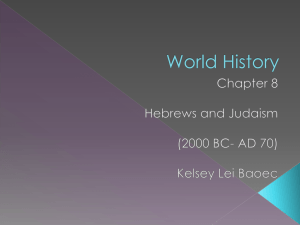Docx
advertisement

1 THE ANCIENT HEBREWS AND JEWS General Remarks The ancient Hebrews exerted perhaps the greatest influence of any ancient peoples on the thought and life of the modern world, which is remarkable given the fact that the Hebrews never had an empire of a widespread and enduring civilization compared with the ancient Egyptians, Mesopotamians, Persians and others. The Hebrews never even had until quite late in their history an organized state or organized church. Why? Their influence was because of their Hebrew scriptures that form the Hebrew Bible or the Old Testament of the Christian Bible. Their influence has been rendered from the Jews’ belief in one God or Yahweh, who demanded righteous behavior from his human creations. This belief is the basis of both Christianity and Islam in later centuries. Probably one of the most controversial subjects by Jews and Christians alike is the creation of humanity by God, and debate has raged vociferously on this. Influences of Hebrews Linguistic scholars have determined that the two different versions of creation are about four hundred and fifty years apart. One relates that God in Genesis 1:26 created man in his own image. “In the image of God he created him: male and female he created him.” In Genesis 2:22 it states “Then the Lord God made a woman from the rib he had taken out of the 2 man. . . “1 No other ancient Near Eastern people are as familiar to us as the Hebrews and their ideas of law and morality as related in the Ten Commandments for example: “Thou shall not kill, “Thou shall not steal,” “Thou shall not commit adultery.” Yet the Hebrew religious beliefs did not spring spontaneously, but evolved over many centuries. The most significant changes transpired from Moses to the Maccabean Dynasty, circa 1250 B.C.E. to circa 150 B.C.E. or eleven hundred years. Their religious beliefs can be delineated in four stages: polytheism, national monolatry, prophetic revolution, and the post exile stage where eschatological doctrines developed that led to monotheism. These stages will be explained as we move through the centuries. Primary Sources Scholars Use What do professional historians use for primary sources to reconstruct the history of the Ancient Hebrews? All that is basically available is the Hebrew Bible itself, with minute archaeological evidence. It is in the first five books of the Hebrew Bible, their Torah, that give us the knowledge of these ancient people, as the ancient Hebrews are mentioned only rarely in primary records of neighboring tribes and nations. 2 Ancient manuscripts are not available. In fact, the oldest complete Hebrew Bible is in St. Petersburg, Russia, and is from the eleventh century C.E. Their scriptures are not Some linguistic scholars relate that the Eve story in Genesis was written at the same time as the Pandora Story by Hesiod for the ancient Greeks. 2 Genesis, Exodus, Leviticus, Numbers, Deuteronomy 1 3 intended as a history in our general sense of the word, but are a complex collection of the following: Historical narrative, wisdom literature, poetry, law, and religious witness. Most biblical scholars today claim that the biblical writers adapted and transformed earlier laws, customs, and mythology from the ancient Mesopotamians, Ancient Phoenicians or Canaanites, and the ancient Egyptians. Scholarship in the nineteenth century tended to discard the Old Testament as a source for history, and even doubted the historical existence of Abraham, Jacob, and Moses. Many scholars today give a more natural explanation for some of the manifestations given in the Torah. Within the Torah, It states that the Israelites escaped from the ancient Egyptian pursuers when the waters of the Red Sea parted. A more scientific explanation has been postulated that the natural place for the Israelites to leave the land of Goshen which is located in the Nile Delta would have been the Reed Sea, located in the swamps bordering today’s Suez Canal. Creation of the Hebrew Bible The Hebrew Bible is not as old as was commonly supposed for centuries. Scholars now give 750 B.C.E. for the beginning date of the writings to the latest from the second century B.C.E. to the first century C.E. Most of it was written down in the seventh century B.C.E. during the Babylonian Captivity, when the New Babylonians under Nebuchadnezzar took many captured Jews to Babylon. Originally it was thought that much was written in Moses’ day, circa the thirteen century B.C.E., and that most of 4 the Psalms were ascribed to King David, whose rule is thought to have begun circa 1000 B.C.E. However, a good many of the Psalms refer to events of the Babylonian Captivity that occurred some four hundred years later. This means that the biblical accounts of early Hebrew History in many cases centuries removed from the events they narrate. We do know that earlier written and oral sources were probably available to these biblical writers, but are lost today. Most biblical scholars assume the Biblical writers and redactors adopted and transformed earlier cultures’ material and contemporary practices of their neighbors. Dead Sea Scrolls With the discovery in the 1940’s and 1950’s of the Dead Sea Scrolls in caves about twenty-some miles from Jerusalem, it was hoped by scholars that more original sources would become available to reconstruct the history of the Hebrews.3 After decades of research and debate, it is now realized that half of the scrolls were of Jewish literary sources, compiling fragments of about four hundred manuscripts with some of the previously known. Onefourth of the manuscripts that were in tattered condition were from the Hebrew Bible, and made up only about two hundred of the manuscripts. The last one-fourth of the pieces of manuscripts were sectarian in nature. No There has been much debate on the community at Qumran near where the Dead Sea Scrolls were found from to determine who might have placed the scrolls in the caves. Ideas brought forth are that it was where the Essenes lived to the site of a large manufacturing site of pottery. 3 5 startling new biblical discoveries were found. It was recognized by biblical scholars that the various Jewish sects even as late as the time of Jesus Christ’s ministry, were arguing and debating what the scriptures said and meant. For many Christians the Old Testament is believed to be divinely inspired revelation, but scholar research has yet to verify this. Abraham and his influence The first stage of the ancient Hebrews’ religious development was polytheistic as the patriarch of the three monotheistic religions, Abraham, came from Ur in Ancient Mesopotamia, where the religious tenets were definitely polytheistic. According to the Bible the Hebrews between 19001500 B.C.E. migrated from Mesopotamia to Southern Syria or Palestine. As quoted in Genesis 11:31 “and Terah took Abram his son. . . and they went forth. . . from Ur.” It is mentioned in the scriptures that they travelled on camels, but these animals were not domesticated until seven hundred years later. Some scholas even think that the name Abraham may be related to the Aryan priestly Caste of the Brahmins in India, and that their patriarchal attitudes may have influenced Abraham and his clan. Abraham entered into an agreement or covenant with his “God of Abraham” “. . . I will establish my covenant between me and thee and they seed after thee in their generations for an everlasting covenant.” Genesis 17:7. Abraham promised not to recognize or worship any other god, he also agreed that he and all his male descendants would be circumcised: “Every man-child among you shall 6 be circumcised.” Genesis 17:11. In return he and his family were taken under special protection of the God of Abraham, and all succeeding generations of his clan renewed this covenant, which was a standard reciprocal contract during these times. During their residence in Palestine, a cave was purchased for the burial site for the patriarchs and matriarchs, which is reverently visited even today. Jacob and the Israelites Experiencing famine in Palestine, the surviving Hebrews under Jacob, Abraham’s grandson, migrated to Egypt, circa 1600 B.C.E. where there were usually plenty of jobs and food, and in the Bible is the story of Joseph being sold into slavery. Now the Hebrews began calling themselves Israelites, which was Jacob’s alternative name after Jacob wrestled with the angel and received the name Israel meaning soldier of God. These passages are in Genesis too. Another version that has intrigued scholars is that this was the time when the Hittites and Egyptians were fighting each other and the Jews became prisoners of war and taken to Egypt. Moses (Mosaic History) Mosaic history under the patriarch Moses is perhaps some of the most well- known stories from The Bible. Moses’ exact dates have not been determined by scholars, but it is suggested they were circa 1400-1200 B.C.E. It is thought by Christians and Jews today that Moses led his band of 7 followers who were enslaved out of Egypt, an event known as the Exodus. For forty years Moses and the Israelites wandered in the wilderness of the Sinai desert. It is believed that under Moses’ leadership, the Israelites were forged into a unified people. God’s name was now Yahweh and traditionally translated as Jehovah. Archaeological and biblical scholars have searched extensively in the Sinai Peninsula for artifacts dating from this time, but all that has been recovered are Egyptian items. The plan was to move back to Canaan, and this is when the second stage of the Hebrew’s religious developments occurred. This is referred to as National Monolatry and spans the timeframe from circa 1250 to 750 B.C.E. Monolatry is a special type of monotheism which means the exclusive worship of Yahweh, but without denying other gods exist. This is when Moses received the Ten Commandments from Yahweh. The Israelites agreed to worship no other gods for God had chosen the Hebrews to set an example of righteous behavior for other nations. Many of the moral precepts, rituals, and taboos as outlined in the Hebrew Bible come from this period. Entering Canaan It was impossible for these Jews to move in and settle down in Canaan for the land was occupied by many other tribes, including the Canaanites or Phoenicians, the Philistines and the Amorites. This necessitated the Jews fighting their way in. According to the Bible, Joshua, who by now was the leader replacing Moses, brought the walls of the city of Jericho tumbling 8 down almost immediately. However, archaeologists and others biblical scholars believe that this probably was a two-hundred year process. Much more evidence is becoming available for scholars to research this timeframe. The topography of this region is very dry and the water source is unpredictable, so for the Israelites as they moved into this area, they had to grow their own crops, besides herd their animals. The indigenous people here were worshipers of Baal and Astarte, and this influenced the Jews to at times abandon their worship of Yahweh and accede to the religious views of strangers. When matters were strained, the Jews elected when necessary a wise man or judge to assist them in any predicament that they might encounter. One of the famous judges according to the Bible was Deborah, whose leadership in the fight against the Philistines is noted. Establishment of the Kingdom Under Saul, David, and Solomon Samuel, as one of the other notable judges appointed Saul as the first king of the Jewish nation. Saul’s reign marked the beginning of national unity for the Jews, and he is followed by what many believers call the Jewish Golden Age under their kings David and Solomon. Again, all these above events are only recorded in the Hebrew Bible. Modern biblical archaeologists continue to excavate Jerusalem and its environments, but so far much of this history cannot be substantiated. Currently, in modern Jerusalem, what is thought to be the city under David is undergoing research. In the Bible it states that King David ruled for forty years from 1000-961 B.C.E. There is the famous 9 story in the Bible about David and Goliath: “So David prevailed over the Philistines with a sling and with a stone.” 1 Samuel 17:50.4 A great number of sling stones have been found in Palestine, with some being three inches in diameter. Using slings was a much older method used for both hunting and war. At this time the Jews put aside their pastoral life style and took up either farming or an urban occupation. Their goal was to build a splendid capital and religious center at Jerusalem. When David died his son by Bathsheba ruled for about forty years too, and he apparently was determined to finish his father’s work. Biblical scholars have pondered why the Jews felt it necessary to build a capital city. Several suggestions have been offered: if the Israelites were to take their place among the great nations, a magnificent capital as a visual manifestation of their greatness was necessary and secondly, a temple was necessary to reaffirm their national religious commitments that would compare favorable with other great nations. Again, according to the Bible, King Solomon spared no expense to build this temple, fortifications, roads, and many palaces. In the temple was where the Ark of the Covenant with the 10 Commandments was located. The Phoenicians as major manufacturers and builders at the time were hired to build this edifice. Unable to pay their construction debts, the Israelites ceded land to the Phoenicians, and Solomon also drafted and In 1993 Israel archaeologists found an inscription referring to the House of David, from the early ninth century B.C.E. 4 10 deported Jews to work for the Phoenicians. This provoked bitter antagonism especially in the Northern area. Division of the Kingdom and Attacks by Assyrians After the death of Solomon, the North rebelled and refused to pay taxes to pay for the Temple when they were unable to benefit from it. This resulted in the northerners seceding from the united Hebrew state and set up their own kingdom of Israel with their capital at Samaria. The southern half was called the Kingdom of Judah with the capital staying at Jerusalem. With this political division came religious divisions. Israel managed to survive by paying tribute for two centuries under Assyrian domination, but by 722 B.C.E. the Assyrians conquered Israel and forced their flight into exile. This is where the eight tribes were dislodged and have not resurfaced. Scholars now have artifactual evidence of the Assyrians leading the Jews into exile. The Assyrian king Sennacherib now was determined to attack and capture the southern kingdom of Judah. First to fall after two sieges was the city of Lachish in 701 B.C.E. only twenty miles from Jerusalem. Apparently Jerusalem was able to hold out for up to one hundred years, for it was a well-fortified city. Babylonian Captivity As the Assyrians were attacking Jerusalem, they in turn were captured by the New Babylonians under their king Nebuchadnezzar in 587 B.C.E. 11 Many of the leading Jewish citizens were taken to Babylon, which is called the Babylonian Captivity, where they lived for fifty years from 587-538 B.C.E. This is when most biblical scholars think that the majority of the Hebrew Bible was committed to manuscript form instead of oral transition. Prophetic Revolution Prophets kept Yahweh’s religion alive in the midst of the far older Babylonian religious practices. This is called by scholars the third stage of the Jews’ religious development or the Prophetic Revolution. It happened concurrently with the political changes that were on going. The prophets such as Amos, Hosea, Isaiah, Jeremiah, and Ezekiel gave freely of their advice to the Jews and served as social critics as well as great poets. Their dates are usually given as 750 B.C.E. to 550 B.C.E. thus it was during the Assyrian and then the Babylonian attacks. While a prophet today means someone who predicts the future, its meaning during the Prophetic Revolution was closer to preacher. These prophets had an urgent message they avowed came from divine inspiration. While there are many intriguing stories in the Bible, scholars have delineated three basic doctrines that are the core principals of the prophets’ teachings: complete monotheism where Yahweh is the ruler of the universe and other gods are false gods. Secondly, Yahweh is a God of righteousness and goodness, who wants only good things to happen to his chosen people. He is not responsible for evil, only humans are responsible for evil. Thirdly, Yahweh demands ethical behavior 12 from his chosen children. He cares less for ritual and sacrifice. Justice, relieving the oppressed, and protecting the orphans and widows are now the most important goals. Influence of the Ancient Persians During the Babylonian Captivity, the Persians under the King Cyrus the Great conquered Babylon circa 538/9 B.C.E., and he allowed 40,000 Jews to return to Palestine. Although many Jews stayed in Babylon, those who returned established their rule semi-independently under the Persians. With Persian monetary assistance they rebuilt the tenth century temple. In the centuries to come Palestine was conquered first by the Greeks and later by the Romans. The Maccabean Dynasty and Roman Rule The Jewish Maccabean dynasty attempted to rule the Jews, but this only lasted for about one hundred years. When the Roman General Pompey turned Palestine into a Roman Protectorate, in 66 C.E. discontented Jews revolted, and the famous epic battle at Masada, an ancient Roman fortress near the Dead Sea, saw a prolonged Roman siege (72-3 C.E.) resulting in what is thought to be mass suicide by the Jews in order to avoid capture. In 70 C.E. the Roman Emperor Titus put down the Jewish uprising and razed their temple in Jerusalem. It has never been rebuilt, and what remains of this second temple is the western or wailing wall, a major pilgrimage site for 13 Jews around the world. During these centuries when the Jews were first under the Persians, and then other rulers, is when the fourth stage of the Jews’ religious development occurred. Post-Exile Period This is now called the post-exile period spanning from the 6th century to the second century B.C.E. There is evidence according to biblical scholars that show the influence not only of Zoroastrianism, the older Persian religion, but Hellenistic ideas. The major contributions during this fourth stage were eschatological doctrines or what would happen at the end of time, plus predictions for the future. Jewish thinkers pondered their role in what appeared to be a small and politically weak nation. What would their role be? This is when the idea of a messiah and messianic expectations occurred. Yahweh would soon send them a national savior or messiah (anointed one) who would life the Jews up to greatness, and spread the worship of Yahweh to the entire world. There would be a millennium of peace and justice before the end of time. At first it was assumed the kingdom of peace would be in this world (Isaiah 61:11), but as this did not happen, then they looked for other triumphs. The chosen Messiah would preside over a last judgment by supernatural means and all the deceased of the world would be resurrected to stand judgment. Evil people would be condemned to eternal suffering and the chosen ones to heaven. 14 Diaspora Once the temple was destroyed, the Jews gradually left for other parts of the vast Roman Empire, an event called the Diaspora. This continued until the formation of the modern Israel state following World War II in 1948. Now more than seven million Jews live there. From the Diaspora to when the Muslims captured Jerusalem in 636 C.E. the Talmud and other documents were written to record the ceremonial and civil laws and legends of the Jews. Ancient Hebrew Society Ancient Hebrew society developed and changed over the many centuries, and it is clear that when they moved from a nomadic way of life raising flocks of goats and sheep to one of living in cities, their social customs were altered. Their early nomadic life meant living in tents like the Bedouins in Arabia today. A long-established law states that once a year for the Feast of Tabernacles, a Jew should try to live for a week in woven goat hair tents like they did at one time. Today certain orthodox Jews in New York City observe this festival by setting up tents on the fire escapes of their apartments. It appears that the nomadic life was always the ideal. Even after centuries of urbanization, city life was identified with sin and corruption. In the Bible the cities of Sodom and Gomorrah were sinful essentially because they were cities. Their exact location has intrigued 15 believers for centuries with the main consensus locating them under the southern waters of the Dead Sea or Salt Sea of the Hebrew Bible. Today dead trees encrusted with thick layers of salt might be reminiscent of what happened to Lot’s wife, who was turned into a pillar of salt when she disobeyed the command not turn look back on the city according to the biblical story. Many of the other occurrences related in the Bible have people looking for a more scientific reason than Yahweh’s power. The Torah What has always been known is that Jewish life in the past and primarily for the orthodox Jews today has been regulated by the Torah. There are over six hundred laws (of Moses) contained in the Torah. Laws were present that included every aspect of the Jewish life cycle from how to wear one’s hair to dietary regulations. Eating pork was explicitly excluded, and there are some scholars who think it was initially because the pig was a major source of meat for the Canaanites who were settled farmers and the pig was sacrificed to their gods. Marriage and Family Customs Marriage customs of the ancient cultures are fascinating to explore as they are so different from our modern ones. Parents arranged their marriages for the ancient Jews, and many still do today, especially the mother or another matchmaker. Boys were to be married by the age of 16 eighteen and girls by the age of twelve to thirteen. Some betrothals were carried out when children were even younger. First cousins married like in other ancient Near Eastern cultures. The marriage ceremony was a civil one, not a religious service. Children were welcomed in Jewish marriages, and there does not appear to be any practice of infanticide. One of the Ten Commandments was “Honor thy father and mother.” A custom first done by the Ancient Hittites, the levirate marriage custom was adopted by the Jews. Brothers were legally bound to marry their brother’s widow. If a brother was not available then another male kin was to marry the widow. Their first born son was considered the heir of her first husband so that “his name be not put out of Israel,” Deuteronomy 25.6. While the Hebrews were still nomads one lawful wife with as many concubines as they could afford was the practice. It was when they adopted settled urban life that polygamous marriages were legalized. Because mothers often died giving birth, having more than one wife would ensure an heir. 5 The wife was the pillar of the family. Her work and wisdom were respected and treasured. A virtuous wife was revered and honored as it says in the Bible in Proverbs: “Who can find a virtuous woman for her price is far above rubies. . . While divorce was available only to the husband for any reason, it was not common. The wife was free to remarry if divorced. Adultery, however, was only punished Historical demographers estimate that for centuries twenty percent of mothers died in childbirth or shortly thereafter. 5 17 by death for the wife, but not for the husband, definitely showing the double standard. Summary In summary of the influence and history of the ancient Jews, probably the Leviticus 19:18 verse “you shall love your neighbor as yourself” is a common theme. In the ancient Hammurabi Code it was acceptable to pay a fine for murder, in the Hittite civilization a murderer could be pardoned by the king, paying restitution, but the Jewish penalty for murder was death. Thus the moral precepts of the Jews led to the belief in the worth and dignity of the individual. This legacy will percolate down through the centuries, and especially in the art and architecture of the Middle Ages and Renaissance periods.









